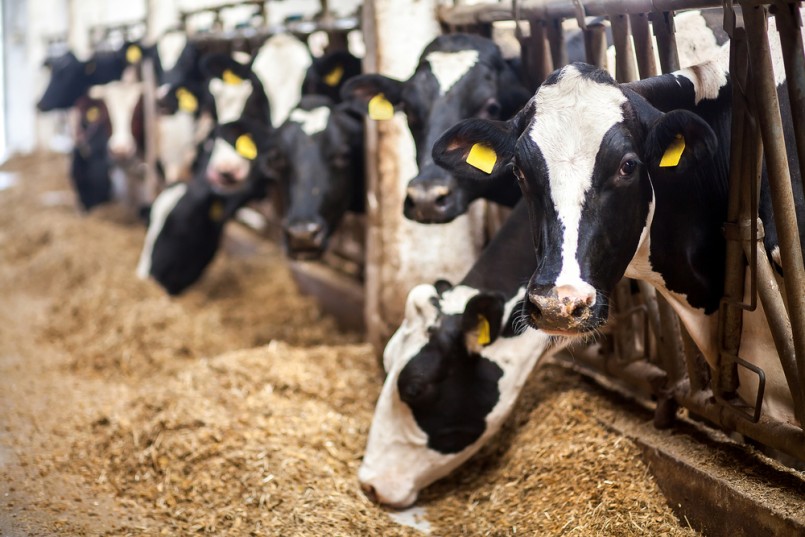Environment
How antibiotic overuse in farm animals may be creating a new public health crisis

Image: ArtemZ/Shutterstock
Over 2 million people become ill annually from antibiotic-resistant bacteria infections in the United States—and from that number, around 23,000 of them die, says the Center for Disease Control and Prevention. Globally, the Review on Antimicrobial Resistance reports even higher figures at 700,000 deaths yearly from several drug-resistant illnesses. Sadly, those numbers do not appear to be shrinking in spite of worldwide medical advances. But why?
Antibiotic overuse on industrial farms has grown
A big clue to understanding the problem lies in factory farming practices. From a young age, livestock is typically provided feed containing antibiotics in order to keep them healthy in a crowded, excrement-laden environment, and to make them “grow faster on less food.” Industrial farming, in fact, uses antibiotics even more heavily than humans do (70% of total medically important antibiotic sales are attributed to farm animal use, up at least 23% since 2009). New scientific discoveries have revealed that drug-resistant genes spread faster and more widely on farms than previous believed, making it potentially the largest source of antibiotic-resistant bacteria in existence.
How much and how often?
While humans typically need a doctor’s prescription to get antibiotics, factory farms annually give over 32.2 million pounds (from 2012 figures) of all sorts of antibiotics to their animals with no veterinary supervision whatsoever. Although the use of antibiotics in farm animals seems effective at first, antibiotic overuse actually makes the animals excellent sources of highly resistant microorganisms like MRSA, an antibiotic-resistant staph infection dreaded in hospital settings for its resistance to several classes of antibiotics. (One recent study revealed that 70% of Iowa farm pigs examined tested positive for MRSA) Such strains of resistant microbes survive the regular antibiotics given to farm animals and, through them, easily spread their stronger DNA out to other animals—even different species of animals—as well as other strains of bacteria. Another study revealed that 90% of E. coli in pigs was tetracycline-resistant, as well as an amazing 71% of pigs even in non-antibiotic farms – illustrating how well resistance bacteria can spread.
Sounding the alarm
Natural Resources Defense Council’s senior health officer Dr. David Wallinga, MD, shares his concerns that, “Livestock use of antibiotics is contributing to a public health crisis of antibiotic overuse. It’s you, me and the people we love who will suffer the consequences when the medications we rely on to treat common illnesses no longer work.” To given an idea of how easily these microbes spread, Scientific American’s Melinda Wenner Moyer described that, “By simply driving behind chicken transport trucks, scientists (from John Hopkins School of Medicine) collected drug-resistant microbes (enterococci) from the air circulating within their cars.” (as well as from the lids of pop cans sitting in the cars’ cup holders), and that, shockingly, “Early this year scientists discovered that a gene coding for resistance to a last-resort antibiotic has been circulating in the U.S. and was in bacteria infecting a woman in Pennsylvania.”
Who is getting involved?
According to Wenner Moyer, bacteria will lose their resistance to genes over several generations once their exposure to antibiotics stops – but repeated exposure allows them to evolve resistance mutations and maintain higher reproductive rates, which stay resistant even after the antibiotics are stopped. However, it doesn’t look like there will be much stopping without a push. In response to the FDA’s toothless regulations, as well as the fact that their request of $7 million to study drug resistance in farm animals in 2016 receiving zero dollars from Congress, a coalition of groups including the NRDC asked the FDA to withdraw seven medically-important antibiotics from the hands of agriculturists. Senior Attorney for NRDC Avinash Kar explained that we must end antibiotic overuse on animals that are not sick, just to make them grow larger on less feed.
Who is pushing back?
Most farmers insist there is no need for alarm, in spite of a meta-analysis conducted by researchers from Ohio State University, concluding that “neither the risks to human health nor the benefits to animal production have been well studied.” Good luck studying it, too, claims EcoWatch’s Dan Zukowski. Farms typically keep scientists and reporters (and anyone else deemed non-essential) off their land for a reported fear of them bringing disease in, but some are suspicious of additional, unstated reasons. Customer contracts for farmers have been limited or ended after such visits or observations in the past. With industry lobbyists on the side of factory farming, it appears they don’t need to have much, if any, concern. The Center for Responsive Politics reported that “Major agribusiness and pharmaceutical interests (such as American Farm Bureau Federation) doled out $5,697,492 for lobbying efforts from 2015 to 2016, and five of their 18 lobbyists previously held government jobs.” Cozy relationships and strong lobbying efforts like this most likely spell disaster for any sufficient reform around antibiotic overuse in the near future.
What can we do?
NRDC’s Food and Agriculture Program Director Jonathan Kaplan insists that “If regulators wait for this problem to get any worse, controlling it may no longer be possible. Future generations are going to wonder why the FDA didn’t take real action as these life-saving drugs slipped away from us.” Petitions can be signed on the subject throughout the internet for concerned consumers. Otherwise, until appropriate protective measures are taken, it looks like those who wish to avoid antibiotic use in their meats must look for the necessary organic certification from the USDA assuring consumers that no growth hormones or antibiotics have been used. Organizations like Local Harvest may also be able to help you find organic farms near you. Other than that, going vegetarian or vegan looks better every day.





0 comments